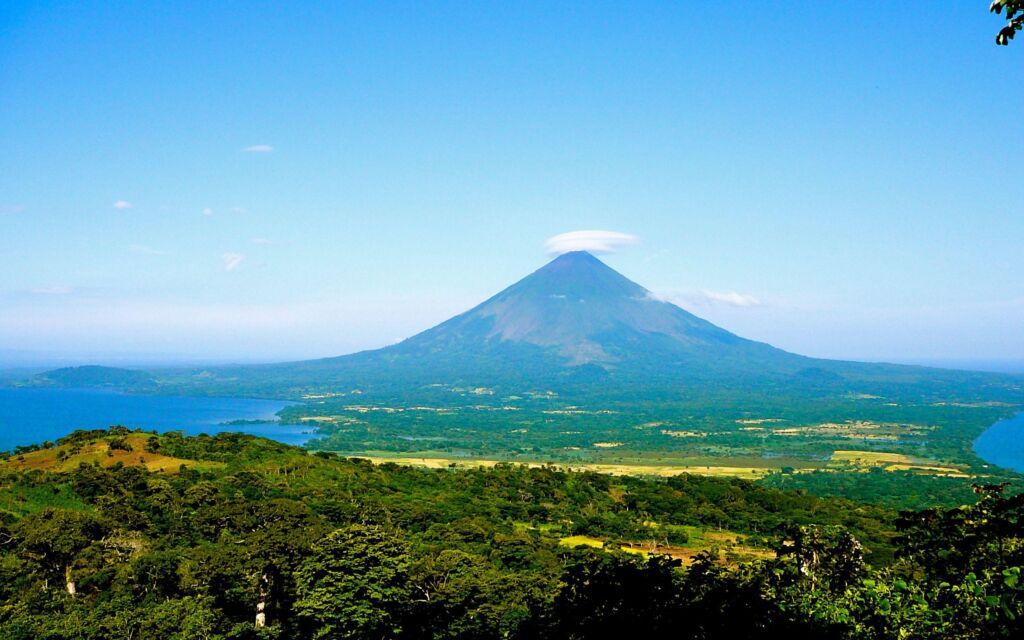Nicaragua is a country in Central America between Honduras and Costa Rica. It covers about 130 000 km² and has coastlines on the Pacific Ocean and the Caribbean Sea. The population is approximately 6.8 million. The official language is Spanish, with indigenous languages such as Miskito and Sumo spoken in some areas. The currency is the córdoba. Alcohol may be legally purchased at age 18, while drugs are prohibited; possession of small amounts is punishable by an administrative fine.
History
Before Spanish arrival, the region was inhabited by Chontal, Nicarao and Miskito peoples. In 1524 Spanish colonists founded the cities of Granada and León. Nicaragua declared independence from Spain in 1821 and joined then left the Federal Republic of Central America. The 20th century saw the Somoza family dictatorship, the 1979 Sandinista revolution and the Contra war in the 1980s. Since 1990, Nicaragua has been a democratic republic with regular elections.
Industry
The economy relies heavily on agriculture – coffee, sugar cane, bananas, cotton and livestock. Textile and footwear manufacturing for export are developed sectors. Tourism and handicrafts have expanded in recent years. Gold and oil extraction remain modest but hold future potential.
Religion and traditions
About 50 % of the population is Roman Catholic, 33 % Protestant of various denominations, around 5 % practice traditional indigenous religions, and 12 % identify as non-religious. Street processions, veneration of patron saints and local feast days are common.
Interesting facts
Lake Nicaragua hosts the largest freshwater island in Central America – Ometepe, formed by two volcanoes. Corn Islands offer world-class surfing. Scenes of the film “Apocalypse Now” were shot here. In 2019, Nicaragua led Central America in free public Wi-Fi speed.
Clothing
Light cotton garments are preferred in cities and on the Pacific coast. Tourists should avoid very revealing outfits – miniskirts, shorts above mid-thigh and open-toe shoes in towns and churches. On beaches and in resort areas, shorts and flip-flops are acceptable. Hats and sunglasses are recommended under the strong sun.
Living standards
Nicaragua ranks as medium in the Human Development Index (HDI 0.661). Average monthly wages amount to about USD 350. It rates low on corruption indices compared to neighbors. Public services are sometimes hindered by bureaucracy and underfunding.
Wars and conflicts
The country endured the 1979 revolution followed by a protracted civil war with the Contras. Hostilities largely ended in the 1990s, though isolated clashes and banditry persist in remote northern areas.
Holidays
The main national holiday is Independence Day on September 15. Major religious celebrations include Holy Week, Feast of Our Lady of Mercy and various patron saint festivals. Christmas and New Year are celebrated with fireworks and family gatherings.
Traditions
Hospitality is paramount – guests are offered the best portions of meals. It is customary to remove shoes when entering someone’s home. Tourists should respect family customs, arrange village visits in advance and ask permission before taking photos.
Tourism
Tourism is a strategic economic sector. Top destinations include the colonial cities of Granada and León with 17th–18th century architecture. Adventure activities feature hikes on active Masaya and Mombacho volcanoes, volcano boarding on ash slopes in León, kayaking on Lake Apoyo and white-water rafting on the Río San Juan. On the Caribbean coast, travelers enjoy surfing on the Corn Islands, snorkeling and diving. National parks offer birdwatching, trekking and photography of toucans and iguanas.
Types of tourism
– Cultural-historical – guided tours of colonial heritage
– Beach – Pacific and Caribbean coasts
– Ecotourism – Miraflor, Somoto and Ometepe reserves
– Adventure – volcano boarding, kayaking, Somoto canyon trekking
– Culinary – cooking classes in local cuisine
– Photo tourism – landscapes of lakes, volcanoes and colonial façades
Tourist attractions
– Granada – the oldest European-founded city in the Americas
– Masaya Volcano – active crater with day and night tours
– Ometepe Island – biodiversity on two volcanoes
– Somoto Canyon – river gorge with waterfalls and cliff jumping
– Apoyo Lagoon – volcanic crater lake with crystal-clear water
– Corn Islands – white-sand beaches and Creole culture
Non-touristy attractions
– Remote coffee farms on Mombacho’s slopes
– Masaya fish markets with authentic seafood feasts
– Antique workshops in León
– Village festivals in Miraflor mountains
– Small indigenous communities on the Caribbean coast
Local cuisine
Signature dishes include pico de gallo, gallo pinto (rice and beans), vigorón (cabbage with fried yuca and pork), indio viejo (meat stew) and nacatamal (corn tamale). Beverages feature sirope (fruit syrup drinks) and guaro (sugarcane rum), plus the local beer Toña. Breakfast is served from 7 to 9 AM, the main meal at 1–2 PM and a light dinner at 7–8 PM. Spicy salsas vary in heat, so tourists are advised to start mild.
Why visit
Nicaragua blends pristine nature, colonial charm and affordability. Visitors can explore unique volcanoes, surf Pacific waves and relax on Caribbean isles. It offers fewer crowds and warmer hospitality than many neighboring countries.
Safety for tourists
Crime rates are higher than regional averages – petty thefts occur in cities and on beaches. There is no terrorism threat. Wildlife risks include crocodiles at river mouths, venomous snakes in jungles and mosquitoes carrying dengue and chikungunya – repellents are essential.
Service level
Accommodation ranges from hostels and guesthouses to eco-lodges and three-four star hotels. Restaurants offer street food and upscale dining in tourist hubs. Rural areas provide modest but friendly service.
Entry rules
Most nationalities receive a 90-day tourist permit on arrival or enter visa-free. A valid passport and return ticket are required. Customs restricts up to USD 10 000 cash; weapons, drugs and pornographic materials are prohibited.
Transport
Intercity buses include „chicken buses“ and comfortable Tica Bus coaches from main terminals. Tickets are bought at stations or online. In cities, minibuses and taxis without meters are common – fares should be agreed in advance. Domestic flights to Corn Islands operate via La Costeña.
Automobile
Car rental is available in Managua and major tourist centers. Local drivers often disregard traffic laws, and minor bribes at police stops happen. There are no toll roads. The legal blood-alcohol limit is 0.0 ‰. Speed limits are 60 km/h in towns and 80 km/h outside. Speed cameras are rare; dashcams are recommended. Main highways are in good condition, while rural roads can be potholed. SUVs or 4×4 vehicles are advised. Fines range from 2 000 to 5 000 córdobas.
Noise regulations
Quiet hours are generally from 22:00 to 6:00. In tourist areas parties may run later, but in residential zones noise is prohibited after 23:00.
Daily tourist budget
Budget – USD 25–35: hostel lodging, street food, buses. Comfort – USD 50–75: guesthouse or three-star hotel, restaurants, tours. Premium – from USD 150: four-five-star hotel, private guides, transfers.
What is not recommended or strictly forbidden
Avoid participating in street protests, photographing police or military sites, swimming in prohibited areas, displaying valuables in public and lingering in poorly lit districts.
Climate
A tropical climate with a dry season from November to April and a wet season from May to October. The Pacific coast is hot and dry; the Caribbean side is humid and muggy. Mountains remain cooler, down to 20 °C. The best travel period is December–April, with minimal rainfall and comfortable temperatures.
- Chile
- How a traveler can earn on the road
- Unadsdalur Church
- Norway’s Atlantic Road scenic drive
- Luo
- Haruto Takahashi Found Pirate Treasure in Madagascar and Rowed It Home
- Indians
- The European Airline Ticket Market in 2025: Digitalization, Flexibility, and Emerging Challenges
- Normandy
- Rising prices for travel in Germany in 2025: reasons, scale and consequences
- Bolivia
- Pirate places of the world: where to travel for seafaring legends
- Macau
- Greenland
- Birds
- Issyk-Kul
- The World of Varans
- Treasure in the Cape Cod fog: A Thai traveler’s encounter with pirate history
- Archaeological expedition of the Hermitage discovered a unique artifact of the Stone Age at excavations in the Serteyskaya Valley
- Distant Storms Create Dangerous Surf at East Coast Beaches












